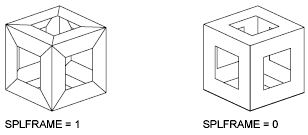You can create polygonal mesh forms. Because the faces of the mesh are planar, the mesh can only approximate curved surfaces.
You can use meshes if you need hiding, shading, and rendering capabilities that wireframe models cannot provide but do not need the physical properties that solid models provide (mass, volume, center of gravity, moments of inertia, and so on).
You can also use meshes to create geometry with unusual mesh patterns, such as a 3D topographical model of mountainous terrain.
The visual style controls how a mesh is displayed, either wireframe or shaded. (VISUALSTYLES command)
You can create several types of meshes.
The mesh density controls the number of facets, and is defined in terms of a matrix of M and N vertices, similar to a grid consisting of columns and rows. M and N specify the column and row position, respectively, of any given vertex.
A mesh can be open or closed. A mesh is open in a given direction if the start and end edges of the mesh do not touch, as shown in the following illustrations.
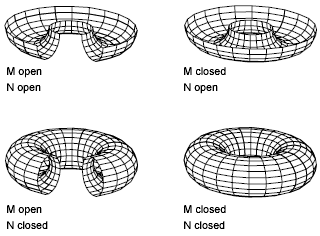
There are several methods for creating meshes.
With RULESURF, you can create a mesh between two lines or curves. You can use two different objects to define the edges of the ruled mesh: lines, points, arcs, circles, ellipses, elliptical arcs, 2D polylines, 3D polylines, or splines. Pairs of objects to be used as the “rails” of a ruled mesh must both be either open or closed. You can pair a point object with either an open or a closed object.
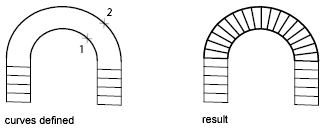
You can specify any two points on closed curves to complete RULESURF. For open curves, construction of the ruled mesh is based on the locations of the specified points on the curves.
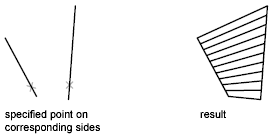
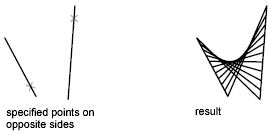
With the TABSURF command, you can create a mesh representing a general tabulated surface defined by a path curve and a direction vector. The path curve can be a line, arc, circle, ellipse, elliptical arc, 2D polyline, 3D polyline, or spline. The direction vector can be a line or an open 2D or 3D polyline. TABSURF creates the mesh as a series of parallel polygons running along a specified path. You must have the original object and the direction vector already drawn, as shown in the following illustrations.

Use the REVSURF command to create a revolved mesh by rotating a profile of the object about an axis. REVSURF is useful for mesh forms with rotational symmetry.
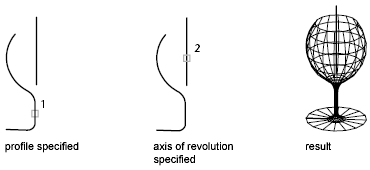
The profile is called a path curve, which can be any combination of lines, circles, arcs, ellipses, elliptical arcs, polylines, or splines, closed polylines, polygons, closed splines, or donuts.
With the EDGESURF command, you can create a Coons surface patch mesh, as shown in the following illustration, from four objects called edges. Edges can be arcs, lines, polylines, splines, and elliptical arcs, and they must form a closed loop and share endpoints. A Coons patch is a bicubic surface (one curve in the M direction and another in the N direction) interpolated between the four edges.

The 3D command creates the following 3D shapes: boxes, cones, dishes, domes, meshes, pyramids, spheres, tori (donuts), and wedges.
To view the objects you are creating with the 3D command more clearly, set a viewing direction with 3DORBIT, DVIEW, or VPOINT.
In the following illustrations, the numbers indicate points you specify to create the mesh.

With the 3DMESH command, you can create polygon meshes that are open in both the M and N directions (similar to the X and Y axes of an XY plane). You can close the meshes with PEDIT. You can use 3DMESH to construct very irregular meshes. In most cases, you can use 3DMESH in conjunction with scripts or AutoLISP routines when you know the mesh points.

In the following example of text at the command prompt, you enter the coordinate values for each vertex to create the mesh in the illustration.
Command: 3dmesh
Mesh M size: 4
Mesh N size: 3
Vertex (0, 0): 10,1, 3
Vertex (0, 1): 10, 5, 5
Vertex (0, 2): 10,10, 3
Vertex (1, 0): 15,1, 0
Vertex (1, 1): 15, 5, 0
Vertex (1, 2): 15,10, 0
Vertex (2, 0): 20,1, 0
Vertex (2, 1): 20, 5, -1
Vertex (2, 2): 20,10 ,0
Vertex (3, 0): 25,1, 0
Vertex (3, 1): 25, 5, 0
Vertex (3, 2): 25,10, 0
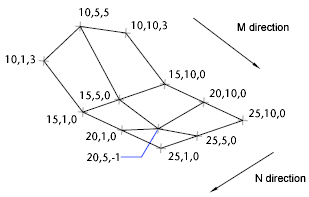
The PFACE command produces a polyface (polygon) mesh, with each face capable of having numerous vertices. PFACE is typically used by applications rather than by direct user input.
Creating a polyface mesh is similar to creating a rectangular mesh. To create a polyface mesh, you specify coordinates for its vertices. You then define each face by entering vertex numbers for all the vertices of that face. As you create the polyface mesh, you can set specific edges to be invisible, assign them to layers, or give them colors.
To make the edge invisible, enter the vertex number as a negative value. For instance, to make the edge between vertices 5 and 7 invisible in the following illustration, you enter the following:
Face 3, vertex 3: -7
In the illustration, face 1 is defined by vertices 1, 5, 6, and 2. Face 2 is defined by vertices 1, 4, 3, and 2. Face 3 is defined by vertices 1, 4, 7, and 5, and face 4 is defined by vertices 3, 4, 7, and 8.
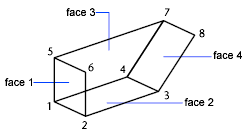
You can control the display of invisible edges with the SPLFRAME system variable. If SPLFRAME is set to a nonzero value, the invisible edges become visible and can then be edited. If SPLFRAME is set to 0, the invisible edges remain invisible.
